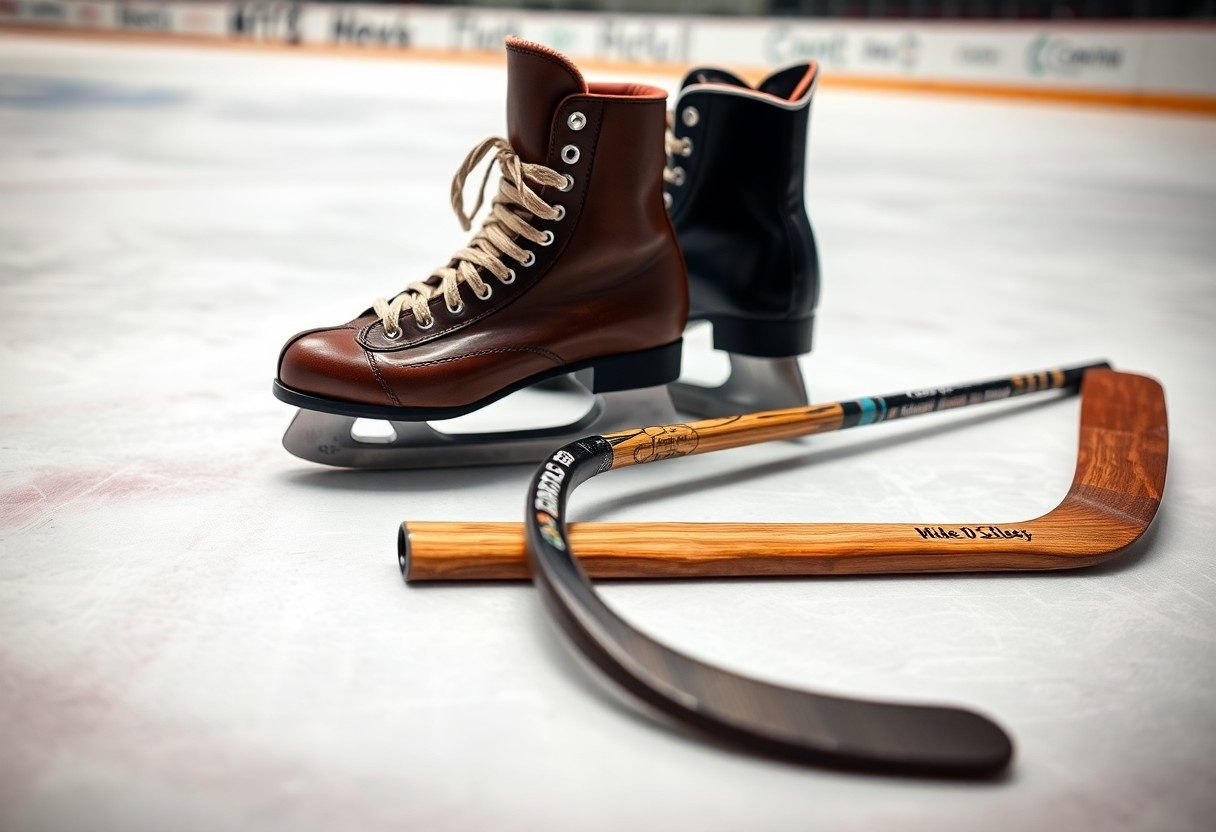There’s a fascinating journey behind the hockey equipment you use today, showcasing an impressive blend of tradition and innovation. As you lace up your skates or strap on your pads, it’s vital to appreciate how far the sport has come. From the humble beginnings of leather skates to the advanced materials and designs that modern technology has introduced, each development has played a pivotal role in enhancing player performance and safety. Join us as we explore this evolution and uncover how past innovations shape your experience on the ice today.
The Early Days of Hockey Equipment
To truly appreciate the evolution of hockey equipment, you must first look back at its early days. The sport has its roots in the 19th century, where players utilized rudimentary gear made from natural materials. At this time, your primary concern was protecting yourself while engaging in a fast-paced game on frozen surfaces, so innovation came about as players sought better solutions.
Leather Skates: The Beginning
Behind the scenes of hockey’s inception were leather skates, a groundbreaking advancement that provided players with the necessary support and speed on the ice. These skates featured a basic design, often crafted from locally sourced leather, and were attached to metal blades. You can imagine the thrill of gliding across the ice with this new level of performance, despite the limited functionality compared to modern designs.
Wooden Sticks and Simple Pucks
For early hockey players, wooden sticks and simple pucks formed the basis of their gameplay. These sticks were hand-carved and designed for both passing and shooting, while pucks were often made from wood or rubber, varying in size and weight. You would find that these basic tools were effective for the time, enabling players to develop vital skills and tactics.
Hence, wooden sticks and handmade pucks were fundamental to shaping the game of hockey. The limited technology challenged players to enhance their technique, relying on skill rather than equipment performance. Over time, these simple materials laid the groundwork for more advanced designs, as the demands of the sport increased and technology began to advance, paving the way for the innovative gear you see today.
The Rise of Synthetic Materials
It is during the late 20th century that synthetic materials revolutionized hockey equipment. The introduction of lightweight and durable fabrics changed the game, enhancing player performance while providing better protection. As traditional leather gave way to innovative materials, hockey sticks, pads, helmets, and skates became more advanced, enabling players to excel on the ice.
Introduction of Plastic and Composite
Between the 1980s and 1990s, plastic and composite materials started to infiltrate the world of hockey. Sticks made from fiberglass and carbon fiber offered greater strength and flexibility, allowing for improved shot accuracy and power. As manufacturers embraced these materials, you saw the production of gear that was not only lightweight but also more resilient against the rigors of hockey play.
Impact on Performance and Safety
Across the hockey community, the shift to synthetic materials has had a profound impact on both performance and safety. The lightweight nature of new equipment has helped players move faster and with greater agility, while enhanced padding has provided superior protection against injuries on the ice.
In fact, the advancements in synthetic materials have significantly improved your on-ice experience. Equipment designed with composite materials reduces the overall weight, enabling quicker maneuvers and faster skating. Additionally, modern padding materials often feature better shock-absorption properties, helping to minimize the risk of injuries from impacts and falls. As a result, you benefit from both enhanced performance and increased safety during play, allowing you to focus on the game rather than worrying about equipment limitations.
Protective Gear Advancements
If you think about the harsh realities of hockey, protective gear is indispensable. Over the years, advancements in technology have transformed the way players safeguard themselves against injuries. Early players relied on simple leather pads and rudimentary helmets, but today, you benefit from exceptionally engineered gear designed to absorb impact and provide superior protection. These enhancements not only offer physical safety but also allow for increased confidence and performance on the ice.
Evolution of Helmets and Pads
For hockey players, the evolution of helmets and pads has been remarkable. Initially, helmets were just soft caps made from cotton or leather, providing minimal protection. Today’s helmets feature hard shells, multi-density foams, and customizable fittings that enhance safety without sacrificing performance. Likewise, shoulder pads, shin guards, and other protective items now utilize lightweight materials that offer maximum protection while allowing for freedom of movement, ensuring that you can play at your best.
The Role of Technology in Protection
Gear technology continues to evolve, significantly enhancing your safety on the ice.
In fact, modern protective equipment employs cutting-edge materials like Kevlar and carbon fiber, which provide lightweight strength and increased durability. Innovations such as impact-absorbing foams and moisture-wicking fabrics help to keep you dry while guarding against injuries. Additionally, advanced designs are tailored to fit the unique contours of your body, optimizing both comfort and mobility. With ongoing improvements, your protective gear is becoming smarter, ensuring you can enjoy the game with reduced risk while maintaining peak performance.
Goaltender Equipment Innovations
All athletes know that the game evolves, and goaltenders are no exception. From simple leather gear to high-tech protective equipment, every innovation aims to enhance safety and performance. The pursuit of optimal protection and agility continues to shape goaltending gear, ensuring you have the tools necessary to excel in your role between the pipes.
From Basic Gear to Advanced Technology
Goaltender innovations have transformed the landscape of hockey, providing you with superior safety and performance capabilities. These changes reflect a commitment to evolving the game and enhancing your skills on the ice.
| Year | Innovation |
| 1910 | Introduction of padded gloves |
| 1960 | Invention of the goalie mask |
| 1980 | Wider and lighter pads |
| 2000 | Composite materials for helmets and pads |
| 2020 | Custom-fit, tech-driven designs |
Specialized Goalie Pads and Masks
Beside overall advancements in gear, specialized goalie pads and masks have revolutionized your game. With innovations in materials and design, these items ensure you remain agile while effectively protecting yourself from serious injury. Modern pads are lighter yet more protective, allowing for quicker movements as you defend against fast-paced shots.
Masks are not just protective devices; they have become imperative tools for performance. Today’s goalie masks incorporate state-of-the-art materials that superbly absorb impacts while featuring personalized designs that reflect your style. These advancements ensure that you can focus on the game while trusting your equipment to handle whatever comes your way.
The Role of Technology in Modern Equipment
For today’s hockey players, technology plays an integral role in the development and performance of equipment. With advanced materials and engineering techniques, modern skates are lighter and more durable than ever, providing you with the agility and support needed on the ice. Additionally, innovations in helmet design ensure better protection through impact-resistant materials and improved ventilation, allowing you to focus on your game while minimizing the risk of injury.
Smart Equipment and Wearable Technology
By harnessing the power of smart technology, equipment manufacturers are creating gear that not only enhances performance but also tracks your stats in real-time. Smart helmets, sensor-embedded skates, and specialized training devices gather data on your speed, stride, and even fatigue levels. This information empowers you to make informed decisions about your training and performance on the ice.
The Future of Hockey Gear
Around the corner, the future of hockey gear promises even more exciting advancements, driven by emerging technologies. Equipment will evolve to become lighter, more responsive, and tailored to your specific needs using artificial intelligence and machine learning. These innovations will allow you to optimize your skills and performance metrics while ensuring maximum comfort and protection during play.
Considering the rapid pace of technological advancements, you can expect personalized gear that adapts to your unique playing style and biomechanical needs. As smart fabrics and 3D printing techniques gain traction, your gear may even be customizable to fit your preferences and measurements perfectly. These developments will rival any other sports equipment, elevating your competitive edge while enhancing overall game experience.
Summing up
Ultimately, you can see how the evolution of hockey equipment has significantly transformed the game, from the humble beginnings of leather skates to the advanced technology of today’s gear. This progression not only enhances your performance and safety on the ice but also reflects broader advancements in materials science and design. Understanding this history allows you to appreciate the complexities of the sport and the importance of using modern equipment to elevate your game to new heights.












